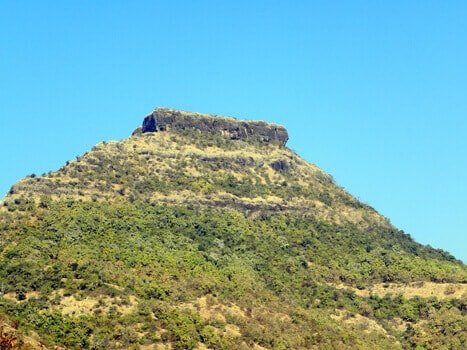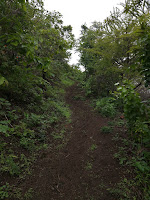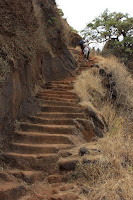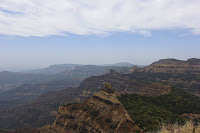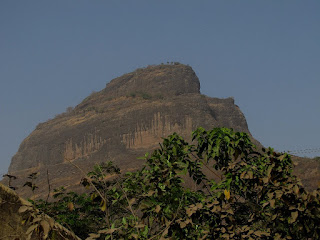 |
| Vairatgad as seen from Vyazwadi |
Basic Facts
Name: Vairatgad (वैराटगड)Base village: Vyazwadi (व्याजवाडी)
Nearest town: Wai (वाई)
Distance from Pune: approx. 95 kms.
History: Trekshitiz
Vairatgad is a small fort located near the town of Wai in Maharashtra, India. It takes around 30 minutes to get to the base village from Wai. Unfortunately, I do not have the local transport details this time, however, you can get them by calling the Wai State Transport Bus Depot.
Not much to say about the fort, besides what's already been said at the above link.
The Route
The route begins from the village of Vyazwadi. You can ask any villager you come across and they should be able to point you to the start of the trail.The trail itself is well trodden and marked as well, so there's little chance of getting lost here. Although, if you visit the fort in the monsoon, the markings may be hidden in the undergrowth.
The trail can be divided into three sections; the rocky road, the traverse and the slipper. The entire trail with the exception of the traverse section has an average incline of 40-45 degrees. Also there is very little tree cover anywhere on the trail, so I would caution against visiting this fort in the summer.
It should take you around 30-45 minutes to clear the first two section and another 20-30 minutes to clear the third. A note of caution. The trail, specifically the third section, get extremely slippery during the monsoon.
As you come to the end of the third section, you will be able to see a perpendicular trail with the citadel looming over you. If you go left here, you'll come upon a series of water tanks carved into the cliff and massive bee hives above you. Continuing on this path will take you to what the locals call नाक टेकडी (literally, Nose hill) and descend from there to a different village altogether.
Take a right here will lead you to the stairway of the citadel and the ruins of what must have been the doorway.
As you come up on the fort, you can see two temples and a lake on your left.
Looking to the right, you can see a chain of fortifications and another small temple.
It will take around 20-30 minutes to take a walk around the entire fort.





